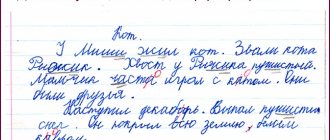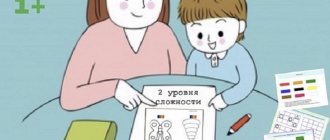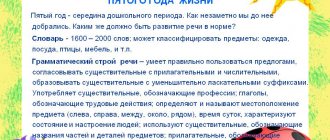What is dysgraphia? How do you know if your child has dysgraphia?
As a rule, parents and teachers learn that a child has problems with writing (dysgraphia) only when teaching writing, that is, in elementary school. Dysgraphia is a specific writing disorder when a child writes words with phonetic errors or errors in recording sounds. Instead of “p” he writes “b”, instead of “t” - “d”, forms syllables incorrectly, adds extra letters, omits necessary ones, writes several words together.
Dysgraphia can be mistakenly mistaken for simply ignorance of grammatical rules, but the problem lies deeper.
Compare “sentence” - “suggestion” and “sentence” - “addition”. In this example, the difference between simple ignorance of the correct spelling (rules) and dysgraphia is clearly visible.
Moreover, the handwriting of such children is often illegible and uneven. When writing, the child shows a lot of effort, but writes very slowly. If such a child studies in a class with ordinary children, he may experience serious worries because of his mistakes, slowness, and the teacher’s dissatisfaction. In speech, a child with dysgraphia often cannot construct long sentences and prefers to remain silent or speak briefly. Because of this, the dysgraphic person does not have full communication with his peers, and it seems to him that his classmates are opposed to him.
| Dysgraphia - this is not a mental illness, but it will not “go away on its own.” It is a brain-related writing disorder. Contact the professionals - the department of child psychotherapy and neuropsychology, which works with cases of dysgraphia, dyslexia, stuttering and other developmental features of children. License No. LO-77-01-009904. Contact us by phone: +74999400734 or +79150066186 - WhatsApp As an advertisement |
Unfortunately, this is a rather serious problem that “does not go alone”: most often dysgraphia manifests itself together with dyslexia, a reading problem, and the child may also have problems with speech and disorders of other physical functions.
Dysgraphia in primary schoolchildren: correction, exercises, prevention
Dysgraphia in primary schoolchildren: correction, exercises, prevention.
Primary school students often suffer from a speech therapy disorder – dysgraphia. It is characterized by certain types of writing disorders: children write as they speak, miss letters, change endings. This is actually a very serious problem. If you do not pay attention to solving it, the child may develop an inferiority complex. Peers at school will make fun of him, which will lead to a loss of confidence in his abilities. Therefore, dysgraphia in younger schoolchildren (correction, exercises and prevention will be presented below) should become an important topic for discussion among parents.
Reasons for appearance
Scientists have not yet identified the exact reasons why this disease occurs. This issue has not yet been fully studied, but most experts agree that the basis for the development of the disease is heredity. Causes of dysgraphia in younger schoolchildren: Heredity. As already noted, this is the main reason for the appearance of the disease. Children accept from their parents immaturity of the brain in certain parts. Because of this, there is a delay in the development of certain functions. Functional sources. This refers to various bodily diseases. For this reason, a violation of psycho-speech development occurs, and the child also loses the ability to read and write. Correction of dysgraphia and dyslexia in younger schoolchildren should be aimed primarily at eliminating the causes of the disease. Underdevelopment of the brain. Any injury or damage can cause dysgraphia. Moreover, brain damage could occur as a result of pathologies during pregnancy, asphyxia, or exposure to infection. Socio-psychological influence. Of course, we cannot forget about this factor. This disease can develop in children due to incorrect speech of people around them, lack of communication, as well as inattention to the child’s writing and reading on the part of parents. Types of dysgraphia in primary schoolchildren Identifying the forms of the disease will help parents correctly apply the exercises recommended by the speech therapist.
You need to know that there are three main types
of this disease:
Acoustic.
This form of dysgraphia appears as a result of a disorder in the development of speech hearing. That is, the child is not able to perceive sounds correctly. Because of this, writing suffers; children unknowingly change letters in words because that’s how they hear. Similar sounds are mixed and often confused, for example b-p, z-zh, s-sh and others. Acoustic dysgraphia affects the softness of consonants in writing (loves - lubits). Also, the child often misses letters. Correction of acoustic dysgraphia in younger schoolchildren is carried out with the help of exercises aimed at improving the auditory space.
Motor
. This problem manifests itself in the form of incorrect hand movements while writing. At the same time, the child can perform other actions. Violation of the combination of visual and sound images is usually the cause of the motor form of the disease. Correction of dysgraphia in younger schoolchildren of this type is aimed at completely getting rid of this ailment. As a result, the child will be able to write correctly and compare images.
Optic
. Dysgraphia of this type manifests itself in visual impairment. Children cannot write letters correctly, which results in mirror writing, substitution, or mixing of different elements. In most cases, similar letters (t-p) are rearranged. A manifestation of this disease is mirror writing from left to right in left-handed people with certain brain disorders. Optical dysgraphia in primary schoolchildren (correction, exercises are covered in the article) is an important problem in the modern world. Visual impairment is not uncommon. Therefore, it is necessary to pay special attention to this issue.
Types of dysgraphia in younger schoolchildren make it possible to specify treatment in a specific situation. How can dysgraphia be detected? If parents suspect the possibility of developing this disease, it is necessary to undergo examination by a neurologist or ophthalmologist. The level of speech growth is checked by a speech therapist. The main thing is to correctly determine whether a child has dysgraphia or whether it is simply a banal ignorance of spelling norms.
. Examination of children
for the presence of dysgraphia includes: Testing oral speech. Particular attention should be paid to this aspect, especially the pronunciation of sounds, vocabulary, and the correct construction of sentences. Assessment of written language. After the first stage, you need to check the letter. To do this, the child is asked to complete certain tasks. Most often this involves rewriting text, conducting dictation, and reading letters and syllables. Based on the results of these exercises, the degree of development of written speech is determined.
Examination of a child's hearing and vision. As well as monitoring the state of manual and speech motor skills. Prevention of dysgraphia in younger schoolchildren is very important. Tasks for identifying this disease can be different. The most commonly used method is to determine phonemic abilities. Such exercises allow the child to demonstrate his skills: distinguish a specific sound in words; highlight pictures whose names begin with the same sound; repeat several syllables in a row after the teacher; hear incorrect pronunciation and point out mistakes. If the child is very young and does not yet go to school, he may also develop dysgraphia. You can check this by looking at the baby’s drawings. Children who love to draw and do it often are practically not susceptible to this disease. If a child does not like to do this, and all his pictures consist of broken or trembling lines, there is a high probability of developing dysgraphia.
Ways to correct dysgraphia.
Dysgraphia in younger schoolchildren is an urgent problem. As soon as the problem is identified, it is necessary to immediately begin classes with a speech therapist. The program for correcting dysgraphia in younger schoolchildren is determined depending on the form of the disease. Parents should take this problem seriously and follow the recommendations of specialists. Correction of dysgraphia in younger schoolchildren is carried out in the following ways: conducting classes to improve memory; increasing vocabulary; remembering spelling norms; written assignments of various types.
Stages of therapy
Elimination of dysgraphia in primary schoolchildren is carried out in four steps:
- Diagnostics. Here you should often conduct various dictations to check the existing level of grammar. The results obtained need to be analyzed and the first conclusions drawn.
- Preparation. Here they pay attention to the development of memory, thinking, and fine motor skills. It is very important to identify an understanding of spatial relationships.
- Correction. From this stage, the immediate correction of existing deviations begins. All work is aimed at three aspects: grammatical, lexical and phonetic.
The goal is to correct violations and normalize the process of writing and reading.
- Grade. The final step is where all the results are checked and final recommendations are given to parents.
Effective methods for correcting dysgraphia
Here we will discuss in more detail the most effective ways to correct the disease:
Word model.
This exercise looks like this: the child is given a picture on which an object and a diagram of a word are drawn. The student's task is to name the object and then pronounce all the sounds of the word in order. Then match each sound with a letter and write the entire word.
Ebbiehaus method
.
The student receives a sheet of words with missing letters. He needs to insert the missing letters and rewrite the entire word.
Exercise. Insert letters into words and indicate soft and hard consonants before vowels
A - Z. Explain the choice of vowels
.
SHL_PA L_PK_ T_PKA T_HARD
K_MEN M_TA T_SHIELD K_SHA
T_ NO CR_ SIT CH_ 3 ST_ RY
Make up a word.
The schoolchild gets words with the syllables mixed up. He needs to rearrange the syllables, make words from these syllables and rewrite the entire word.
ta, vo, ro -……… you, mo, be, ge -………. Ve, ka, shal - ……….
lod, ho-…………… Tu, ar, tro-……. ….. Le, vi, chok, so — ………
mo, gra, ta-………… bi, army, for-………… Pi, kra, va-……………
chik, boron, for-……… before, about, in, water-…… flax, dar, ka-………….
Analysis of sounds and letters
.
The child is given a picture depicting a certain object. He needs to name this thing and write the word. Then put emphasis, divide into syllables and say them out loud. Each sound must be separated and emphasized with the appropriate color. Then you need to compare their number with the number of letters.
Correcting errors
.
Here everyone gets a few words with intentional mistakes. The student’s task is to correct this and rewrite the words in the correct form.
"Writing out loud"
This is probably one of the most effective exercises. There is no substitute for it; the essence is to speak out loud what is written, with the obligatory emphasis on the weak parts. This should be done slowly, pronouncing each letter clearly. For example: a cow gives milk. The exercise is aimed at improving literacy levels. Weak beats are sounds that are not given attention during fluent speech and are pronounced incorrectly. An important point is to pronounce the word to the end, highlighting the endings. Children suffering from dysgraphia can very rarely write a complete word. They often put sticks at the end that can be mistaken for letters. However, the number of these lines does not correspond to the number of letters that should be in this word. With the help of this task, acoustic dysgraphia is corrected in primary schoolchildren.
Exercises aimed at treating the disease are quite varied. But the fundamental one is “Write Out Loud.” You need to teach your child to pronounce every written word, and then the result will not be long in coming.
Exercise “Corrector”
To complete this task you will need a boring text or a complex book. The point is that the child is not interested in reading. The only requirement is large letters to distinguish what is written. First, you need to choose an easy letter (usually a vowel) that the child knows and does not make mistakes in writing, for example “a”. The student’s task will be to find mentions of this letter and cross it out. Then you should move on to a more complex stage. You can increase the number of letters; it is advisable to choose similar spellings, for example “l” and “m”.
It is very simple to understand what exactly is causing difficulties for a child. It is necessary to conduct a dictation, in the process of writing which the student will make certain mistakes. Based on these errors, weaknesses in grammar can be identified.
Correction of optical dysgraphia in younger schoolchildren is carried out using this exercise. It is very effective, since you need to strain not only your brain, but also your eyes. It must be emphasized that the text should not arouse interest in the child. He does not need to read, but to find the shape of the letter.
Exercise “Find and Explain”
To complete this task you will need several dictations written by the child. He must explain every comma placed in a particular sentence. If he does not have enough knowledge, he needs to tell the student the rules along the way. It’s even better if the teacher pushes the student to the correct answer so that he can guess and formulate his decision. When performing the exercise, it is important to remember not to overload the child. It is recommended to parse five to six sentences from each dictation. The correct answer must be stated several times. For example, a comma between the noun “sun” and the pronoun “we” separates parts of a complex sentence. It should be noted that after each dictation it is necessary to work on mistakes. As part of this task, acoustic dysgraphia is corrected in primary schoolchildren.
The “Find and Explain” and “Write Out Loud” exercises are the most effective for solving this problem.
Labyrinth quests
and “
Find the missing letter.”
These two exercises are quite popular, and most parents use them to develop their child’s abilities. They are also useful for correcting dysgraphia
. Labyrinth quests
“Labyrinth” perfectly develops gross motor skills of children. Currently, there are a huge number of different collections where you can find excellent puzzles. If desired, parents can draw the labyrinths themselves. The child’s main task is to trace with a finger or pen from the beginning of the intricate moves to the end. The organization of prevention and correction of dysgraphia in primary schoolchildren can be based on this exercise. It is the simplest and most universal.
Exercise “Find the missing letter”
aimed at developing attentiveness in children. To implement it, you need the source text, where everything is in its place. Then in the same material you need to remove the letters, leaving gaps in their place. The student’s task is to fill in the missing elements. The source text should not be removed, as the child needs something to build on. When searching for material, you need to take into account the fact that it should interest the student. In this case, completing the task will turn into a game.
Recently, dysgraphia has been developing more and more often in younger schoolchildren. Correction, exercises and prevention of this disease are simply necessary to protect the child from unpleasant consequences.
Handwriting correction
The fact is that for a child with dysgraphia, handwriting causes a certain difficulty. Typically, such children write either very small or extremely large. Sloppy handwriting is not a negative thing, and you shouldn’t scold a child for it. It will take about three weeks to teach a student to write correctly. First, you need to purchase a squared notebook and ask to reproduce the text on paper. The letter should not go beyond the cell - the main rule. You need to monitor this and support the child in every possible way. You cannot overload children; a few correctly written lines a day are an excellent result. Even if parents are tired of working with their child, it is strictly forbidden to show it, much less raise their tone.
It is recommended to use pens with a ribbed surface as writing instruments, as well as pencils in the shape of a triangle. At home, you can play with your child by giving him a pen and ink. Then he will try to write correctly so as not to spoil the game.
Recommendations from speech therapists.
- Parents should work with their children, because the child’s future depends on it.
- Completing tasks requires perseverance and patience.
- In addition, exercises should be done regularly, at least an hour a day. If a specialist has specified a large amount of information for processing, then the text must be divided into several parts. This will make it easier for both the child and the adult.
- Overwork should not be allowed, as this will lead to whims and decreased performance.
- The most common mistake is rewriting homework several times. Parents should not force their children to do this, because it will not lead to anything good. On the contrary, the child will make a large number of mistakes, which will lead to reluctance to study.
- Support is very important, even in the most insignificant situation. Did your child complete the task? You need to praise him, but in moderation. This issue requires delicacy; you cannot overdo it. Never humiliate a child for failure. Moreover, it is forbidden to invent offensive nicknames. This negatively affects the child's psyche.
Prevention Prevention of dysgraphia in younger schoolchildren can be expressed in impaired auditory recognition of speech sounds. From the age of 3, it is necessary to constantly check this point. If a child of this age has problems, they can be easily solved with regular exercise. With the wrong approach to learning, a child may develop dysgraphia or dyslexia. You should also pay attention to the correct pronunciation of words by adults. If parents repeat after their children, this can lead to certain problems. If a child speaks incorrectly, he must be immediately taught how to do it. Then he will remember better and speech will develop faster.
Types of dysgraphia
- Articulatory-acoustic . It is due to the fact that the child pronounces sounds incorrectly, which means that when he pronounces them to himself, he writes them down incorrectly. To treat this type of dysgraphia, you need to work on the correct pronunciation of sounds.
- Acoustic . In this case, the child correctly pronounces sounds, but confuses them with similar sounds (voiceless-voiced: b-p, d-t, z-s; hissing: s-sh, z-zh; and also does not distinguish the softness of individual sounds) .
- Optical . A child with optical dysgraphia has difficulty writing and distinguishing letters: he adds extra elements (sticks, dashes, circles), skips the necessary ones, even writes in a mirror image in the opposite direction).
- Dysgraphia due to problems in language analysis and synthesis . A child with this problem in writing may skip or repeat entire words, rearrange syllables and letters, write different words together (they confuse prefixes and prepositions on nouns - write together or separately, attach part of the next word to one word, etc.)
- Agrammatic dysgraphia . As a rule, it is detected after grades 1-2, as it requires greater knowledge of the rules of writing words (“good cat”, “beautiful sun”, etc.). That is, this problem is due to the fact that the child cannot correctly inflect words by gender and case, and cannot agree on an adjective and a noun. This problem can be observed in bilingual (bilingual) families, as well as when a child is taught in a non-native language.
Methods for identifying dysgraphia
Identification of dysgraphia is a complex process, which is based on solving the following problems:
- Distinguish an illness from ignorance of the rules of spelling words.
- Distinguish between this type of disorder and pathologies of the organs of vision, hearing, and ENT organs.
- Determine the form of the disease.
If there is a suspicion that a child has a pathology, you should consult with specialists:
- ophthalmologist - will see eye diseases and cerebral circulation disorders;
- otolaryngologist – examines for diseases of the throat, ears and nose;
- the dentist will see defects in the structure of the teeth, which may interfere with the correct pronunciation of words and indirectly contribute to their illiterate spelling;
- neurologist - will determine the state of the central nervous system and the problems existing in this area;
- speech therapist - will identify the presence of oral speech defects and their relationship with errors in writing, determine the type of dysgraphia.
The main stages of diagnosing dysgraphia are:
- Research of written works.
- Study of the patient’s physical, mental, speech development, condition of the organs of vision and hearing.
- Examination of the articular apparatus, manual and speech motor skills, determination of the dominant hand.
- Study of the level of sound perception, sound pronunciation, vocabulary of the child, knowledge and use of lexical and grammatical basics.
- Conducting a writing test.
Written language analysis involves identifying the disorder by presenting the child with various written tasks, after which a verdict is made. Types of written tasks for diagnosing dysgraphia: copying from handwritten and printed texts, describing pictures, dictations, tests.
In preschool children, the risk of subsequent problems with writing is identified by the quality of their drawings. Potential dysgraphics aged 3-6 years are drawn reluctantly, with uneven lines, abruptly, and unclearly. This is often due to undeveloped finger muscles and poorly developed hand motor skills.
Causes of dysgraphia
The reasons for this disorder can be very different: from birth injuries, infections and genetics to neglected upbringing. When there are problems in the functioning of the brain, dysgraphia is most often accompanied by concomitant diseases, which parents may already be aware of.
In fact, a child who has been diagnosed with dysgraphia cannot write without errors, because the functioning of his speech, auditory, visual and motor analyzers is impaired; the child cannot process information (synthesis and analysis).
How to eliminate dysgraphia and is it possible?
Fortunately, yes, with some effort on the part of both parents, specialists, and the child himself, dysgraphia can be corrected and cured . Of course, this is not a quick process: it may take months or years of systematic training to completely overcome dysgraphia and accompanying writing, speech and reading disorders. But these efforts will be rewarded: the child will be able to fully study in a regular school and become a full-fledged member of society, an ordinary child.
Dysgraphia is not a death sentence, you can live with it, but the task of parents and teachers should be to overcome this illness. Fortunately, many methods and exercises have been developed to eliminate dysgraphia. This is confirmed by famous people suffering from dyslexia and dysgraphia. Here is just a small list of names: Hans Christian Andersen, Albert Einstein, Tom Cruise, Salma Hayek, Cher, Dustin Hoffman, Walt Disney, Fyodor Bondarchuk, Vladimir Mayakovsky, Marilyn Monroe.
Which doctor treats dysgraphia?
Dysgraphia is usually reported by the child's teacher. He may already have experience working with such children. Next, you should contact a speech therapist and neuropsychiatrist. The main work is carried out by a speech therapist: he develops both hemispheres of the brain, teaches him to distinguish, pronounce and record sounds. A neuropsychiatrist will help identify concomitant disorders (if any), understand the causes of dysgraphia and prescribe medication. In some cases, other specialists are involved in solving the problem, for example, if a child has hearing problems, he can neither hear sounds nor record them.
Difficulty reading and writing
In Russia, reading difficulties are called dyslexia, and writing difficulties are divided: there is dysgraphia (children in strong positions cannot correlate sound and letter) and dysorthography (children do not have spelling skills). In English-speaking countries, dyslexia refers to impairments in reading and the ability to write or spell a word. Dysgraphia includes problems with handwriting and problems with the wrong choice of writing form while transmitting sounds correctly quite often.
To understand why dysgraphia and dysorthography are distinguished separately in Russia, we need to turn to the tasks that children face when mastering literacy.
- Mastering regular sound-letter correspondences - mastering the phonetic principle of writing. Students and teachers solve this problem mainly in the first grade.
- Mastering the regular spelling of morphemes is a morphological principle of writing. For example, if they write vody, then in the word “water” the unstressed vowel should be “o”.
- Mastering the traditional spelling of words is a historical principle of writing. For example, there are no rules that explain why the word “compote” should be written this way. Traditional spelling also includes those words that we pronounce in one way and write in another: for example, in the word “his” we pronounce the sound [v] and write “g”.
These principles have different meanings in different languages. The first priority in importance and complexity for Russian children is the morphological principle, for the English – the historical principle, for the Germans – the phonetic principle.
In the Russian tradition, difficulties in mastering regular sound-letter correspondences are classified as dysgraphia, and difficulties in mastering morphological and traditional writing are referred to as dysorthography. Dysgraphia is dealt with primarily by speech therapists, and spelling errors are usually left to teachers.
How legitimate is this division and what problems lie behind the development of regular sound-letter correspondences and the development of spelling? To answer, we will look at the systematic structure of writing in first grade when mastering the phonetic principle.
To master the simplest skill of writing (write what you hear), many components of our behavior and psychological operations are required (Fig. 3).
Rice. 3
If a teacher dictates to first-graders the phrase “Mom is cooking porridge,” then only the child who can maintain optimal tone of the cerebral cortex will cope with this task (1): a hyperactive or hypoactive child will not cope. The first block of the brain is responsible for this.
As the teacher dictates, the child turns on the processing of auditory information - these are the temporal areas, primarily the left hemisphere (2).
A child, having heard the word “cook,” cannot identify all the sounds using auditory information alone. Children in the first grade pronounce what they have to write - this attracts impulses that go from our articulatory organs to the brain and allow us to analyze what sounds we pronounce. This is the processing of kinesthetic information, for which the parietal lobe is responsible (3).
We must move from sound to letter. The processing of visual information is activated, for which the occipital lobe is responsible (4). There are two possible ways of processing visual information. The transition from a sound we hear to a letter is an analytical approach that is carried out by the left hemisphere. Sometimes a child knows the spelling of a whole word, for example, the word “mom,” then he can imagine a picture, a complete visual image of the word. In this case, the child actively uses not only the left hemisphere, but also the right.
To determine where to start writing, the processing of visual-spatial information is activated. The area that is responsible for this process is located at the junction of the temporal, parietal and occipital regions in the left hemisphere (5). In the right hemisphere, the processing of visual-spatial information is more diffuse, and it is leading in spatial functions.
It's time to write, and the front parts of the brain turn on. Premotor areas of the frontal lobe (6) control the serial organization of graphic movements. If the serial organization of graphic movements is poorly mastered, the child may make unnecessary movements or write an insufficient number of letter elements (then the letter “w” will turn into “i”). All components must work together, the prefrontal region of the frontal lobe is responsible for this (7), which provides programming, regulation and control of writing.
Some of these components may lag behind; more often, nearby zones that are responsible for related processes lag behind. Based on this, we can identify the main types of dysgraphia.
1. Acoustic-articulatory (phonemic) dysgraphia - weakness of components 2 and 3, which are responsible for processing sound perception and kinesthetic organization. Speech therapists know this dysgraphia best: children mix sounds that are similar in sound (for example, voiceless and voiced: “barrel” - “kidney”), similar in pronunciation: [zh] and [z] (Fig. 4).
Rice. 4. Example of acoustic-articulatory dysgraphia
2. Regulatory dysgraphia - problems with serial organization and programming of the act of writing (components 6 and 7). The child cannot concentrate on the desired task, cannot get involved in it, and is easily distracted. For example, in Fig. 5 we see that in the word “feels” the child inertly repeats the writing program, repeats the word “already”, and can skip both a letter and an entire syllable.
Rice. 5. Example of regulatory dysgraphia
3. Visual-spatial dysgraphia. In this type of dysgraphia, both hemispheres are involved: weakness of components 4 and 5, which provide orientation on a sheet of paper, maintaining a line, tilting letters, etc. In the example in Fig. 6, the psychologist dictated the phrase “There were two boys with us on the ship,” it is difficult to understand whether the student wrote the prepositions together or separately, in the word “us” the letter “i” jumped out before the “m” and was repeated again at the end of the word, as if it were printed, and not capital.
Rice. 6. Example of visuospatial dysgraphia
With all forms of dysgraphia, there are specific dysgraphic errors (problems with the phonetic principle of writing) and spelling errors (difficulties with the morphological and historical principles).
There are general and specific mechanisms behind spelling errors. The common mechanism is the high energy intensity of manual writing. A particular mechanism for insufficient development of the morphological principle for acoustic-articulatory dysgraphia is the problem of updating related (test) words. They do not automatically pop up and require a random search.
In regulatory dysgraphia, such a mechanism is problems of “spelling vigilance” (as a special case of poor orientation in a task).
Insufficient working memory and a tendency to simplify programs lead to errors, despite knowledge of the rules.
A particular mechanism for insufficient mastery of the historical and morphological principles of writing in visuospatial dysgraphia is the problem of mastering the holistic visual image of a word, caused by the weakness of the right hemisphere holistic strategy. The child compensates for it using the phonetic principle.
Our preliminary findings are supported by a neuropsychologically oriented analysis of writing and eye movements during reading (Korneev, Akhutina, Matveeva, 2019), including when reading regular and irregular words (Rybchinskaya, Korneev, Akhutina, 2018). They are consistent with data on the two best predictors of reading level: phonemic tasks and the rapid digit naming test (Dorofeeva et al., 2020; Moll et al., 2014; Kuperman and Van Dyke, 2011).
Work to overcome writing difficulties should include special exercises both for mastering the recording of sounds in strong positions and for developing basic spelling skills:
- finding related words,
- spelling vigilance training,
- development of visual memory.
What should teachers and parents do?
Eliminating such a problem cannot be done alone: parents, teachers and doctors must unite and agree on their actions. Prescribe treatment, perform certain exercises. Perhaps the child should be transferred to another school (specialized) or hired a tutor who can professionally perform exercises with the child at home.
We must not forget that “dysgraphics” are very often acutely aware of their problem and are afraid to manifest it again: they miss lessons, lose notebooks in the Russian language, and communicate little. The task of adults, in addition to treatment, is to provide psychological support to the child: do not scold, show interest in success, help.







